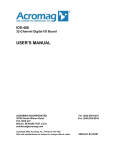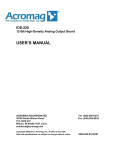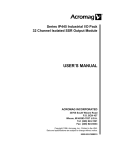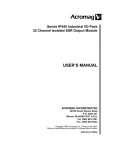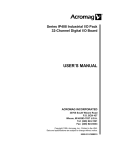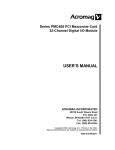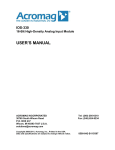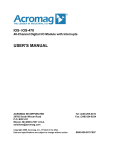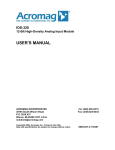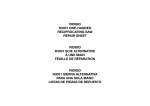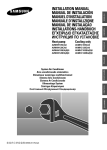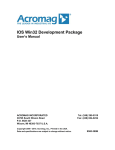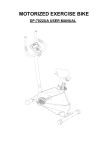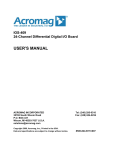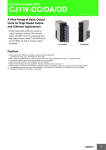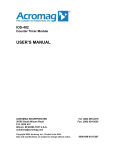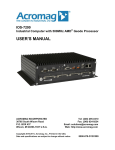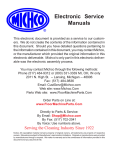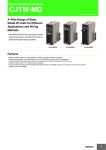Download IOS-445 User`s Manual
Transcript
IOS-445 32 Channel Isolated SSR Output Module USER’S MANUAL ACROMAG INCORPORATED 30765 South Wixom Road P.O. BOX 437 Wixom, MI 48393-7037 U.S.A. [email protected] Copyright 2009, Acromag, Inc., Printed in the USA. Data and specifications are subject to change without notice. Tel: (248) 295-0310 Fax: (248) 624-9234 8500-840-B11C007 SERIES IOS-445 I/O SERVER MODULE 32 CHANNEL ISOLATED SSR OUTPUT MODULE ____________________________________________________ _____________________________________ The information contained in this manual is subject to change without notice. Acromag, Inc. makes no warranty of any kind with regard to this material, including, but not limited to, the implied warranties of merchantability and fitness for a particular purpose. Further, Acromag, Inc. assumes no responsibility for any errors that may appear in this manual and makes no commitment to update, or keep current, the information contained in this manual. No part of this manual may be copied or reproduced in any form, without the prior written consent of Acromag, Inc. Table of Contents 1.0 GENERAL INFORMATION........................................... KEY IOS-445 FEATURES............................................. I/O SERVER MODULE INTERFACE FEATURES........ I/O SERVER MODULE SOFTWARE LIBRARY........... 2.0 PREPARATION FOR USE............................................ UNPACKING AND INSPECTION.................................. BOARD CONFIGURATION........................................... CONNECTORS............................................................. IOS Field I/O Connector (P2).................................... Grounding and Noise Considerations........................ 3.0 PROGRAMMING INFORMATION................................. IOS IDENTIFICATION ROM.......................................... I/O SPACE ADDRESS MAP......................................... REGISTER DEFINITIONS............................................ Control Register........................................................ Port Output Registers................................................ IOS-445 PROGRAMMING............................................ 4.0 THEORY OF OPERATION............................................ OUTPUT PORTS.......................................................... 5.0 SERVICE AND REPAIR................................................ SERVICE AND REPAIR ASSISTANCE........................ PRELIMINARY SERVICE PROCEDURE...................... WHERE TO GET HELP………………………………….. 6.0 SPECIFICATIONS......................................................... GENERAL SPECIFICATIONS....................................... DIGITAL SSR OUTPUTS.............................................. Page 2 2 3 3 3 3 3 3 3 4 4 4 5 5 5 5 5 6 6 6 6 6 6 7 7 7 DRAWINGS IOS-445 RESISTOR LOCATION DRAWING………….. IOS-440/IOS-445 LOOPBACK CONNECTIONS………. IOS-445 BLOCK DIAGRAM......................................... Page 8 9 10 IMPORTANT SAFETY CONSIDERATIONS It is very important for the user to consider the possible adverse effects of power, wiring, component, sensor, or software failures in designing any type of control or monitoring system. This is especially important where economic property loss or human life is involved. It is important that the user employ satisfactory overall system design. It is agreed between the Buyer and Acromag, that this is the Buyer's responsibility. 1.0 GENERAL INFORMATION The I/O SERVER MODULE (IOS) Series IOS-445 module is a bus isolated 32-channel output module. The IOS-445 provides control for 32 solid state relays which are bipolar and may be used to switch positive or negative voltages. Four units may be mounted on a carrier board to provide up to 128 channels of output control in a single system slot. The IOS-445 offers a variety of features which make it an ideal choice for many industrial and scientific applications as described below. Important Note: The following IOS model are accessories to the IOS Server Models: IOS-7200, IOS-7200-WIN, IOS-7400, and IOS7400-WIN; which are cULus Listed. This equipment is suitable for use in Class I, Division 2, Groups A, B, C, and D or non-hazardous locations only. MODEL IOS-445 OPERATING TEMPERATURE RANGE -40 to +85 C KEY IOS-445 FEATURES High Channel Count - Individual control of up to 32 (SPSTNO) bipolar Solid State Relays (SSR‟s) is provided. Four units mounted on a carrier board provide 128 channels in a single system slot. Optically Isolated - Individual bipolar SSR‟s provide isolation. The IOS-445 contains four groups (ports) of eight channels which include separate port commons to ensure port to port isolation. Individual ports are isolated from each other and from the IOS logic. Low-Side or High-Side Switch Configuration - Each group of eight channels can be connected directly to positive or negative supplies for high (hot) side switching. Alternatively, each group of eight channels can be connected to common for low side switching. Socketed pull-up resistors are provided for low side switching applications. TTL Compatible - When configured as a low side switch will sink 27mA at 0.4 volts. Sourcing is controlled by the installed pull-up resistor. Power Up & System Reset is Fail-safe - For safety, the outputs are turned OFF upon power-up and a system reset. Thus, the SSR‟s will be disabled after a power-up or system reset. Wide Range Bipolar Voltage Outputs - Outputs are rated from 0 to 60 volts. The bipolar solid state relays allow both AC and DC switching. Output Readback Function - Readback buffers are provided that allow the output channel registers to be read back. Loopback Compatible with IOS-440 Digital Input Module The P2 field I/O pin assignments of the IOS-445 output module correspond with those of the Acromag IOS-440 Bus Isolated Input module. This provides direct closed-loop monitoring of the output states. -2Acromag, Inc. Tel:248-295-0310 Fax:248-624-9234 Email:[email protected] http://www.acromag.com SERIES IOS-445 I/O SERVER MODULE 32 CHANNEL ISOLATED SSR OUTPUT MODULE ____________________________________________________ _____________________________________ No Configuration Jumpers or Switches - All configuration is performed through software commands with no internal jumpers to configure or switches to set. Conduction Cooled Module - I/O modules employ advanced thermal technologies. A thermal pad and module cover wicks heat away from the module and transfers the energy to a heat spreading friction plate. Heat moves to the enclosure walls where it is dissipated by the external cooling fins. I/O SERVER MODULE INTERFACE FEATURES High density - Single-size, IOS module footprint. Four units mounted on a carrier board provide up to 128 isolated output points in a single system slot. Local ID - Each IOS module has its own 8-bit ID signature which can be read via access to the ID space. 8-bit I/O - Port register Read/Write is performed through 8 or 16-bit data transfer cycles. I/O SERVER MODULE SOFTWARE LIBRARY IOS MODULE Win32 DRIVER SOFTWARE Acromag provides a software product (sold separately) to facilitate the development of Windows Embedded Standard applications interfacing with I/O Server Modules installed on Acromag Industrial I/O Server systems. This software (Model IOSSW-DEV-WIN) consists of a low-level driver and Windows 32 Dynamic Link Libraries (DLLS) that are compatible with a number of programming environments including Visual C++, Visual Basic.NET, Borland C++ Builder and others. The DLL functions provide a high-level interface to the IOS carrier and modules eliminating the need to perform low-level reads/writes of registers, and the writing of interrupt handlers. IOS MODULE LINUX SOFTWARE Acromag provides a software product (sold separately) consisting of Linux software. This software (Model IOSSWAPI-LNX) is composed of Linux libraries designed to support applications accessing I/O Server Modules installed on Acromag Industrial I/O Server systems. The software is implemented as a library of “C” functions which link with existing user code. This board is physically protected with packing material and electrically protected with an anti-static bag during shipment. However, it is recommended that the board be visually inspected for evidence of mishandling prior to applying power. The board utilizes static sensitive components and should only be handled at a static-safe workstation. BOARD CONFIGURATION Power should be removed from the board when installing IOS modules, cables, termination panels, and field wiring. Refer to your IOS module documentation for configuration and assembly instructions. Module IOS-445 digital output boards have no hardware jumpers or switches to configure. Software configurable control registers are provided for control of all modes of operation. Refer to section 3 for programming details. This module is built with socketed output pull-up resistors installed. These may be used when the SSR‟s are applied as low side switches. Resistor values may be changed if needed, and the resistors may be removed for high side switching (see IOS-445 RESISTOR LOCATION DRAWING). CONNECTORS IOS Field I/O Connector (P2) P2 provides the field I/O interface connections for mating IOS modules to the carrier board. P2 is a 50-pin female receptacle header (AMP 173279-3 or equivalent) which mates to the male connector of the carrier board (AMP 173280-3 or equivalent). This provides excellent connection integrity and utilizes gold-plating in the mating area. The field and logic side connectors are keyed to avoid incorrect assembly. P2 pin assignments are unique to each IOS model (see Table 2.1) and normally correspond to the pin numbers of the field I/O interface connector on the carrier board (you should verify this for your carrier board). 2.0 PREPARATION FOR USE UNPACKING AND INSPECTION Upon receipt of this product, Inspect the shipping carton for evidence of mishandling during transit. If the shipping carton is badly damaged or water stained, request that the carrier's agent be present when the carton is opened. If the carrier's agent is absent when the carton is opened and the contents of the carton are damaged, keep the carton and packing material for the agent's inspection. For repairs to a product damaged in shipment, refer to the Acromag Service Policy to obtain return instructions. It is suggested that salvageable shipping cartons and packing material be saved for future use in the event the product must be shipped. -3Acromag, Inc. Tel:248-295-0310 Fax:248-624-9234 Email:[email protected] http://www.acromag.com SERIES IOS-445 I/O SERVER MODULE 32 CHANNEL ISOLATED SSR OUTPUT MODULE ____________________________________________________ _____________________________________ Table 2.1: IOS-445 Field I/O Pin Connections (P2) Pin Description Number Pin Description OD00 1 OD20 OD01 2 OD21 OD02 3 P OD22 OD03 4 O OD23 User Supply 0 5 R User Com Out 2 OD04 6 T OD24 OD05 7 OD25 OD06 8 0 OD26 OD07 9 OD27 User Com Out 0 10 User Supply 3 OD08 11 OD28 OD09 12 OD29 OD10 13 P OD30 OD11 14 O OD31 User Supply 1 15 R User Com Out 3 OD12 16 T Not Used OD13 17 Not Used OD14 18 1 Not Used OD15 19 Not Used User Com Out 1 20 Not Used OD16 21 P Not Used OD17 22 O Not Used OD18 23 R Not Used OD19 24 T Not Used User Supply 2 25 2 Not Used Grounding and Noise Considerations Number 26 P 27 O 28 R 29 T 30 2 31 32 33 P 34 O 35 R 36 T 37 38 3 39 40 41 42 43 44 45 46 47 48 49 50 The output channels of this module are divided into four ports of eight channels each. All channels within a port share a common signal connection with each other. Isolation is provided between the ports and the IOS logic which includes the remainder of the I/O Server. In addition, bus isolation is provided between ports. P2 pin assignments are arranged to be compatible with similar Acromag models. This model is directly loopback compatible with the Acromag Model IOS-440 32-Channel Digital Input Board. Likewise, pin assignments are identical to those of Acromag Model IOS-405 40-Channel Digital Output Boards for channels 0-31, except for the user supply connections. See IOS-440/IOS-445 LOOPBACK CONNECTIONS for loopback connections to Acromag Model IOS-440 Input Modules. Note that the outputs of this module are bipolar, and may be connected in any direction with respect to the port common. Further, do not confuse port commons with signal ground. For the IOS-445, port common only infers that this lead is connected common to the 8 outputs of the port (a separate common for each port). The port commons of the IOS-445 output module and IOS-440 input module are normally not connected together for loopback interconnection (see IOS-440/IOS-445 LOOPBACK CONNECTIONS). Output lines of the IOS-445 are optically isolated between the logic and field output connections. Likewise, separate port commons ensure port-to-port isolation. Consequently, the field I/O connections are isolated from the carrier board and backplane, thus minimizing the negative effects of ground bounce, impedance drops, and switching transients. However, care should be taken in designing installations to avoid inadvertently compromising isolation, or creating ground loops which can cause noise pickup and reduce overall system reliability. 3.0 PROGRAMMING INFORMATION IOS IDENTIFICATION SPACE - (Read Only, 32 Even-Byte Addresses) Each IOS module contains identification (ID) information that resides in the ID space. This area of memory contains 32 bytes of information at most. Both fixed and variable information may be present within the ID space. Fixed information includes the "IOS" identifier, model number, and manufacturer's identification codes. Variable information includes unique information required for the module. The IOS-445 ID information does not contain any variable (e.g. unique calibration) information. ID space bytes are addressed using only the even addresses in a 64 byte block The IOS-445 ID space contents are shown in Table 3.1. Note that the baseaddress for the IOS module ID space (see the I/O Server manual) must be added to the addresses shown to properly access the ID space. Execution of an ID space read requires 0 wait states. Table 3.1: IOS-445 ID Space Identification (ID) ROM Hex Offset From ID Numeric ROM Base Value Address (Hex) Field Description 00 49 02 50 04 41 06 43 08 A3 Acromag ID Code 0A 09 IOS Model Code1 0C 00 Not Used (Revision) 0E 00 Reserved 10 00 Not Used 12 00 Not Used 14 0C Total Number of ID ROM Bytes 16 8C CRC 18 to 3E 00 Not Used Notes (Table 3.1): 1. The IOS model number is represented by a two-digit code within the ID space (the IOS-445 model is represented by 09 Hex). 2. Execution of an ID space read requires 0 wait states. -4Acromag, Inc. Tel:248-295-0310 Fax:248-624-9234 Email:[email protected] http://www.acromag.com SERIES IOS-445 I/O SERVER MODULE 32 CHANNEL ISOLATED SSR OUTPUT MODULE ____________________________________________________ _____________________________________ I/O SPACE ADDRESS MAP This board is addressable in I/O space to control the 32 channels of digital output to the field. The I/O space may be as large as 64, 16-bit words (128 bytes), but the IOS-445 uses only a portion of this space. The I/O space address map for the IOS-445 is shown in Table 3.2. Note that the base address for the IOS module I/O space (see your carrier board instructions) must be added to the addresses shown to properly access the I/O space. Accesses may be performed on an 8 or 16bit basis but only D0-D7 are driven. D08-D15 are not used but will normally read high due to pull-up resistors on the carrier board. The following table shows the memory map for the IOS-445. Data is read and written to one of four groups (ports) as designated by the address. Table 3.2: IOS-445 I/O Space Address (Hex) Memory Map2 Base MSB LSB Base Addr+ D15 D07 Addr+ D08 D00 01 Not Used Control Register 00 03 Not Used Output Port 0 CH07 CH00 02 05 Not Used Output Port 1 CH15 CH08 04 07 Not Used Output Port 2 CH23 CH16 06 09 Not Used Output Port 3 CH31 CH24 08 0B Not Used 0A 7F Not Used 7E REGISTER 0 (OUTPUT SWITCHES 00 THROUGH 07): MSB __ __ __ __ __ __ LSB 07 06 05 04 03 02 01 00 CH07....................................................................................CH00 REGISTER 1 (OUTPUT SWITCHES 08 THROUGH 15): MSB __ __ __ __ __ __ LSB 07 06 05 04 03 02 01 00 CH15....................................................................................CH08 REGISTER 2 (OUTPUT SWITCHES 16 THROUGH 23): MSB __ __ __ __ __ __ LSB 07 06 05 04 03 02 01 00 CH23....................................................................................CH16 REGISTER 3 (OUTPUT SWITCHES 24 THROUGH 31): MSB __ __ __ __ __ __ LSB 07 06 05 04 03 02 01 00 CH31....................................................................................CH24 Write a zero to each channel‟s position to turn the corresponding SSR OFF. Write a one to each channel‟s position to turn the corresponding SSR ON. Each output channel register can be conveniently read back for verification purposes. For critical control applications, it is recommended that outputs be directly fed back to an input point and the input point monitored (loopback I/O). Acromag Model IOS440 32-channel isolated input modules can be used to implement loopback output monitoring with this model (see IOS-440/IOS-445 LOOPBACK CONNECTIONS). On power-up, hardware reset, or software reset, the ports are reset to 0 forcing the outputs (SSR‟s) to be OFF. Notes (Table 3.2): 1. The IOS will not respond to addresses that are "Not Used". 2. All Register accesses implement 0 wait state data transfers. REGISTER DEFINITIONS Control Register, (Write) - (Base + 00H) This write only register is used to reset all output ports to 0 (SSR switches OFF). Table 3.3: Control Register BIT FUNCTION 0 1 = Software Reset 1 to 7 Not Used Port Output Registers (Read/Write, 02H, 04H, 06H, and 08H) Four registers are provided to control 32 possible output points. Data can be read from or written to one of four groups of eight output lines (Ports 0-3), as designated by the address and read/write signals. Each port assigns the least significant data line (D0) to the least significant output line of the port grouping (e.g. OD00 for port 0 to D0). -5Acromag, Inc. Tel:248-295-0310 Fax:248-624-9234 Email:[email protected] http://www.acromag.com SERIES IOS-445 I/O SERVER MODULE 32 CHANNEL ISOLATED SSR OUTPUT MODULE ____________________________________________________ _____________________________________ 4.0 THEORY OF OPERATION 5.0 SERVICE AND REPAIR This section contains information regarding the basic functionality of the circuitry used on the IOS-445. Refer to the IOS445 BLOCK DIAGRAM located at the end of this manual as you review this material. OUTPUT PORTS The field I/O interface to the carrier board is provided through connector P2 (refer to Table 2.1). Individual Solid State Relays (SSR‟s) for each channel isolate the field from the control logic for the IOS-445. Channels are isolated from each other in groups of eight. There are eight channels to a group or port. Because the output lines of a single port share a common connection, individual outputs are not isolated from each other within the same port. However, separate port commons are provided to facilitate port-toport isolation. SERVICE AND REPAIR ASSISTANCE Surface-Mounted Technology (SMT) boards are generally difficult to repair. It is highly recommended that a non-functioning board be returned to Acromag for repair. The board can be damaged unless special SMT repair and service tools are used. Further, Acromag has automated test equipment that thoroughly checks the performance of each board. When a board is first produced and when any repair is made, it is tested, placed in a burn-in room at elevated temperature, and retested before shipment. Please refer to Acromag's Service Policy Bulletin or contact Acromag for complete details on how to obtain parts and repair. PRELIMINARY SERVICE PROCEDURE 32 Single Pole Single Throw - Normally Open (SPST-NO, “1 Form A”) SSR outputs are controlled by this module. Each group of eight channels can be connected directly to positive or negative supplies for high (hot) side switching. Alternatively, each group of eight channels can be connected to common for low side switching. Socketed pull-up resistors are provided for low side switching applications. These resistors should be removed if high side switching is needed. In low side switching applications the resistor values can be changed (e.g. lower values will provide a faster pull-up while a higher values will keep power dissipation from becoming a problem at higher voltages) - see Specifications in Chapter 6 for details. The SSR‟s are controlled by output registers within the FPGA. Writing a „1‟ to the output register will turn the switch ON (closedcircuit) while writing a „0‟ will turn it OFF (open-circuit). Readback of the output state is accomplished by reading the output registers. However, for complete confidence in output control, loopback should be performed. This may be accomplished using the IOS440 isolated digital input module (refer to IOS-440/IOS-445 LOOPBACK CONNECTIONS). The SSR‟s employed are rated for a much higher voltage than specified. However, the field connector and printed circuit board foil spacings limit applied voltages to +/-60VDC or AC peak. Each port (group of eight channels) has a single common. Since the connectors and cables are rated to 1A maximum per pin, then each port is limited to that total current. Thus, the sum of currents conducted by the 8 channels must stay below that total (see specifications in Chapter 6 for details). The low on resistance of the SSR‟s helps reduce their power dissipation when they conduct high currents; however, given the large number of channels on the board adequate air circulation must be maintained. The SSR‟s used in the IOS-445 are very rugged and contain built-in current limiting for their protection. They provide clean, bounce free switching and can replace electromechanical relays in many applications. SSR switching speeds are comparable to electromechanical relays (1mS. typical) but are slow compared to high speed optocouplers. Before beginning repair, be sure that all of the procedures in Section 2, Preparation For Use, have been followed. Also, refer to the documentation of your carrier board to verify that it is correctly configured. Verify that there are no blown fuses. Replacement of the carrier and/or IOS with one that is known to work correctly is a good technique to isolate a faulty board. CAUTION: POWER MUST BE TURNED OFF BEFORE REMOVING OR INSERTING BOARDS WHERE TO GET HELP If you continue to have problems, your next step should be to visit the Acromag worldwide web site at http://www.acromag.com. Our web site contains the most up-to-date product and software information. Go to the “Support” tab to access: Application Notes Frequently Asked Questions (FAQ‟s) Product Knowledge Base Tutorials Software Updates/Drivers An email question can also be submitted from within the Knowledge Base or directly from the “Contact Us” tab. Acromag‟s application engineers can also be contacted directly for technical assistance via telephone or FAX through the numbers listed below. When needed, complete repair services are also available. Phone: 248-295-0310 Fax: 248-624-9234 Email: [email protected] Output operation is “Fail-safe”. That is, the outputs are always OFF upon power-up reset, and are automatically cleared following a software (control register) or system software reset. This is done for safety reasons to ensure reliable control of the output state under all conditions. -6Acromag, Inc. Tel:248-295-0310 Fax:248-624-9234 Email:[email protected] http://www.acromag.com SERIES IOS-445 I/O SERVER MODULE 32 CHANNEL ISOLATED SSR OUTPUT MODULE ____________________________________________________ _____________________________________ 6.0 SPECIFICATIONS DIGITAL (SSR) OUTPUTS GENERAL SPECIFICATIONS Output Channel Configuration.......32 isolated Solid State Relay (SSR) outputs supporting AC or DC (high or low side switching) operation. SPST-NO, “1 Form A” contacts. “OFF” Voltage Range.....................0 to +/-60V DC or peak AC. Output “OFF” Leakage Current......1uA Maximum (over temp.). Output “ON” Current Range...........140mA Maximum continuous (up to 1A total per port) No deration required at elevated ambients. Output ON Resistance..................15 , Maximum (25 C). Output Current Limiting..................480mA Maximum. Turn-ON Time................................1mS. Typical, 2mS. Maximum. Turn-OFF Time..............................1mS. Typical, 2mS. Maximum. Reset Condition..............................All output SSR‟s OFF. Output Pull-up Resistors................Socketed 4.7K (used in low side switching applications). See IOS-445 RESISTOR LOCATION DRAWING: Res. Loc. Dwg. Calculate resistor power for user supplied voltage (Power = V2/R). Limit power to 0.1 Watt per resistor (21.7V max. @ 4.7K ). Remove or insert higher value. (consult factory) for higher voltages. Install lower value (check power) to obtain faster, stronger pull-up. Remove for high side switching applications. TTL Compatibility...........................Yes, used as low side switch can sink 27mA. @ 0.4V Maximum; source 500uA @ 2.4V Min. with 4.7K pull-up to 5V supply. Resistance to RFI.........................No digital upsets occur for field strengths up to 10V per meter at 27MHz, 151MHz, & 460MHz per SAMA PMC 33.1 test procedures. Resistance to EMI........................ Unit has been tested with no digital upsets under the influence of EMI from switching solenoids, commutator motors, and drill motors. ESD Protection.............................Output lines are protected from ESD voltages to 4KV. May degrade 4.7K pullups by 5%. Operating Temperature................. -40 to +85 C Relative Humidity..........................5-95% non-condensing. Storage Temperature....................-40 to +125 C. Physical Configuration..................Single I/O SERVER MODULE Length................................... 4.030 in. (102.36 mm). Width.....................................1.930 in. (49.02 mm) Board Thickness....................0.062 in. (1.59 mm) Height……………………........0.500 in. (12.7 mm) Power Requirements: +5 Volts ( 5%) All On.............300mA, Typical 400mA, Maximum. +5 Volts ( 5%) All Off.............8.5mA, Typical 12mA, Maximum. 12 Volts ( 5%) from P1........0mA (Not Used). Isolation.........................................Logic and field connections are optically isolated by SSR‟s. Individual ports are also isolated from each other. However, output lines of individual ports share a common connection and are not isolated from each other. Separate port commons are provided to facilitate port-to-port isolation. IOS Logic and field lines are isolated from each other for voltages up to 250VAC, or 354V DC on a continuous basis (unit will withstand a 1500V AC dielectric strength test for one minute without breakdown). This complies with test requirements outlined in ANSI/ISA-S82.01-1988 for the voltage rating specified. Port to port isolation is less critical and is specified as 100V DC. Isolation Spacing...........................Printed circuit board minimum isolation spacings are as follows: Port-to-Logic: 0.024” Minimum (inner layer), 0.071” Minimum (external layer). Port-to-Port: 0.012” Minimum (inner layer), 0.040” Minimum (external layer). -7Acromag, Inc. Tel:248-295-0310 Fax:248-624-9234 Email:[email protected] http://www.acromag.com SERIES IOS-445 I/O SERVER MODULE 32 CHANNEL ISOLATED SSR OUTPUT MODULE ____________________________________________________ _____________________________________ -8Acromag, Inc. Tel:248-295-0310 Fax:248-624-9234 Email:[email protected] http://www.acromag.com SERIES IOS-445 I/O SERVER MODULE 32 CHANNEL ISOLATED SSR OUTPUT MODULE ____________________________________________________ _____________________________________ -9Acromag, Inc. Tel:248-295-0310 Fax:248-624-9234 Email:[email protected] http://www.acromag.com SERIES IOS-445 I/O SERVER MODULE 32 CHANNEL ISOLATED SSR OUTPUT MODULE ____________________________________________________ _____________________________________ - 10 Acromag, Inc. Tel:248-295-0310 Fax:248-624-9234 Email:[email protected] http://www.acromag.com










